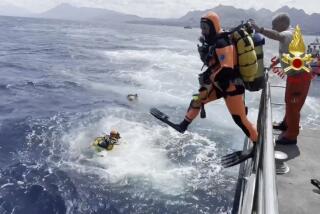Sicily’s Tradition-Bound Tuna Fishermen
- Share via
It will begin any day now, along Sicily’s western coast. The elaborate nets woven in a sequence of chambers that feeds into the square Camera di Morte--Room of Death--have, likely, already been set. A large, intricate cross, adorned with colorful images of Catholic saints, is already aloft, guarding the submerged nets and ensuring their bounty. Now, the fishermen must wait, until bluefin tuna arrive from the Strait of Gibraltar to mate in these waters, and the rais--the captain of this hunt--gives the word to begin la mattanza.
In Italian, “mattanza” means “the capture and slaughter of tuna.” But for the people living in Favignana, one of the Egadi Islands off Sicily, the mattanza is both an age-old tradition and their livelihood. They have been holding mattanze for thousands of years. Generations of fishermen have lain in wait for the giant tuna, have sung hymns to the fish and then trapped them in the Camera di Morte, harpooned them with their gaffes and then wrestled them into special long boats, staining the emerald sea red with the blood of fish.
It is, as Ernest Hemingway once wrote, a “back-sickening, sinew-straining, man-sized job.” In a good year, there will be more than a few mattanze, and 65 tonnaroti--tuna fishermen--will capture as many as 500 fish, some weighing as much as 600 pounds, in a single day. Their harvest will be flown to Japan, where sushi bars charge customers $75 for 2 ounces of bluefin sashimi. Little will remain for the fishermen’s families; the people of Favignana cannot afford to eat their pricey crop.
Theresa Maggio first visited Favignana, and the mattanza, 14 years ago. She was, at the time, a long way from home, an American writer in love with an Italian fisherman, a “good man in a dying trade.” What she saw transfixed her; she thought it “an eruption, a paroxysm. A font of primal energy, beauty, and suffering, all in a tiny square of sea. It was shocking, and most beautiful.”
It is a strange word to use, “beautiful,” to describe such bloodshed. But Maggio has written “Mattanza: Love and Death in the Sea of Sicily” to celebrate the beauty that she found in Favignana, its people and its traditions. And there is such poetry in her spare, often lyrical language that she succeeds. “Mattanza”--part historical text, part travelogue and part memoir--is a paean both to the hunt and to the hunters, the tonnaroti of Favignana, who “still build their trap in the same time-honored sequence every spring . . . [who] observe the rituals, recite the prayers, and chant the songs.”
As we move through the fishermen’s complicated preparations and complex histories, toward the mattanza, the narrative leaps back and forth, jumping between years and stories. In the places where Maggio links the spiritual to the physical, the present to the past, “Mattanza” shines. We feel, as the fishermen do, the weight of history on their shoulders; we experience both the “the desperate fury of the animal” and the “profound silence after the massacre.”
It is remarkable that a woman has succeeded in telling the fishermen’s story, for the women of Favignana are kept away from the tonnara, the tuna nets. Their only job at harvest time is to care for the statue of the Virgin, who the tonnaroti believe watches over them. Perhaps they believe the old superstition that women, like bananas, rabbits and suitcases, bring bad luck to a fishing boat. Yet the men of Favignana allow Maggio on board; they call her a “tonnarota.”
“The sea forgets,” one tonnaroto tells Maggio, and we wish that it were so, that the sea could undergo a sort of amnesia after the violence of the mattanza and other, more efficient slaughters--including long-line and purse-seine fishing--that are arriving in Sicily’s waters. But forgetting is impossible: Fishermen have been snatching up the fish faster than they can reproduce, and the mattanza, like so many age-old cultural traditions, is in danger of dying out. Its survival, it appears, depends on its transformation into a tourist event--if tuna fishing can be Disney-fied.
Maggio has written a book full of grace and glory. “Mattanza” should be cherished by anyone who loves the wind-swept terrain along the Mediterranean, or who wants to understand the fragile, always ethereal relationship between man and the sea.
More to Read
Sign up for The Wild
We’ll help you find the best places to hike, bike and run, as well as the perfect silent spots for meditation and yoga.
You may occasionally receive promotional content from the Los Angeles Times.






